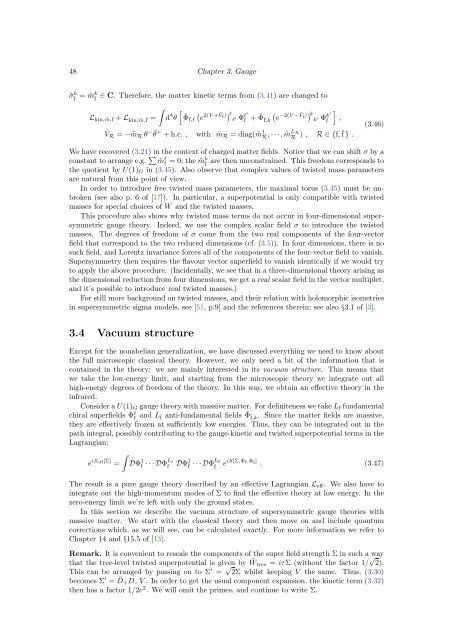The Bethe/Gauge Correspondence
The Bethe/Gauge Correspondence
The Bethe/Gauge Correspondence
Create successful ePaper yourself
Turn your PDF publications into a flip-book with our unique Google optimized e-Paper software.
48 Chapter 3. <strong>Gauge</strong>˜σ k¯f= ˜m k¯f ∈ C. <strong>The</strong>refore, the matter kinetic terms from (3.41) are changed to∫L kin, ˜m,f + L kin, ˜m,¯f =[d 4 (θ ¯Φf,l e2(V +Ṽf) ) l(l ′ Φl′ f + ¯Φ¯f,k e−2(V −Ṽ¯f )) ]kk ′ Φk′ ¯f,Ṽ R = − ˜m R θ − ¯θ+ + h.c. , with ˜m R = diag( ˜m 1 R, · · ·, ˜m L RR) , R ∈ {f,¯f } .(3.46)We have recovered (3.21) in the context of charged matter fields. Notice that we can shift σ by aconstant to arrange e.g. ∑ ˜m l f = 0; the ˜mk¯f are then unconstrained. This freedom corresponds tothe quotient by U(1) G in (3.45). Also observe that complex values of twisted mass parametersare natural from this point of view.In order to introduce free twisted mass parameters, the maximal torus (3.45) must be unbroken(see also p. 6 of [17]). In particular, a superpotential is only compatible with twistedmasses for special choices of W and the twisted masses.This procedure also shows why twisted mass terms do not occur in four-dimensional supersymmetricgauge theory. Indeed, we use the complex scalar field σ to introduce the twistedmasses. <strong>The</strong> degrees of freedom of σ come from the two real components of the four-vectorfield that correspond to the two reduced dimensions (cf. (3.5)). In four dimensions, there is nosuch field, and Lorentz invariance forces all of the components of the four-vector field to vanish.Supersymmetry then requires the flavour vector superfield to vanish identically if we would tryto apply the above procedure. (Incidentally, we see that in a three-dimensional theory arising asthe dimensional reduction from four dimensions, we get a real scalar field in the vector multiplet,and it’s possible to introduce real twisted masses.)For still more background on twisted masses, and their relation with holomorphic isometriesin supersymmetric sigma models, see [51, p.9] and the references therein; see also §3.1 of [3].3.4 Vacuum structureExcept for the nonabelian generalization, we have discussed everything we need to know aboutthe full microscopic classical theory. However, we only need a bit of the information that iscontained in the theory: we are mainly interested in its vacuum structure. This means thatwe take the low-energy limit, and starting from the microscopic theory we integrate out allhigh-energy degrees of freedom of the theory. In this way, we obtain an effective theory in theinfrared.Consider a U(1) G gauge theory with massive matter. For definiteness we take L f fundamentalchiral superfields Φ l fand L¯f anti-fundamental fields ¯Φ¯f,k . Since the matter fields are massive,they are effectively frozen at sufficiently low energies. Thus, they can be integrated out in thepath integral, possibly contributing to the gauge-kinetic and twisted superpotential terms in theLagrangian:∫e iS eff[Σ] =DΦ 1 f · · · DΦ L ffDΦ 1¯f · · · DΦ L¯f¯fe iS[Σ,Φ f,Φ¯f] . (3.47)<strong>The</strong> result is a pure gauge theory described by an effective Lagrangian L eff . We also have tointegrate out the high-momentum modes of Σ to find the effective theory at low energy. In thezero-energy limit we’re left with only the ground states.In this section we describe the vacuum structure of supersymmetric gauge theories withmassive matter. We start with the classical theory and then move on and include quantumcorrections which, as we will see, can be calculated exactly. For more information we refer toChapter 14 and §15.5 of [13].Remark. It is convenient to rescale the components of the super field strength Σ in such a waythat the tree-level twisted superpotential is given by ˜W tree = iτΣ (without the factor 1/ √ 2).This can be arranged by passing on to Σ ′ = √ 2Σ whilst keeping V the same. Thus, (3.30)becomes Σ ′ = ¯D + D − V . In order to get the usual component expansion, the kinetic term (3.32)then has a factor 1/2e 2 . We will omit the primes, and continue to write Σ.
















